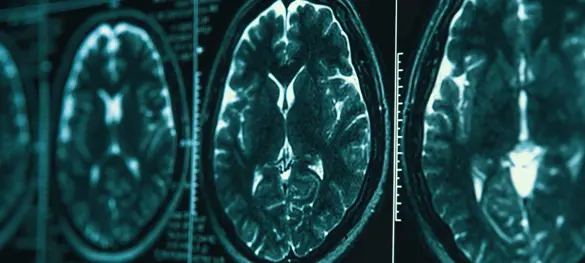AI Tool aims to detect Alzheimer's disease through speech analysis

Scans are one of the tools used to diagnose Alzheimer's disease. Image: DedMityay - stock.adobe.com
A Federation researcher is working to create a tool using artificial intelligence that he hopes will help detect Alzheimer's disease early by analysing how people speak.
Alzheimer's disease is the most common type of dementia, a physical brain condition resulting in impaired memory, thinking and behaviour, where a person's abilities deteriorate over time. The disease creates significant challenges for those diagnosed and their carers. It is estimated that 480,000 Australians currently live with dementia, and more than half of those people have Alzheimer's disease.
PhD candidate Kewen Ding says his project will employ two types of information – the words people say and the sounds of their speech, and by combining these, he hopes the tool will improve the accuracy of diagnosis.
“Speech is a valuable biomarker for Alzheimer's disease because it reflects changes in cognitive functions such as memory, attention, and language. Subtle alterations in vocabulary, sentence structure, fluency, and prosody – the rhythm, pitch, and intonation of speech – can appear early in the disease, often before more obvious clinical symptoms,” he said.
“Alzheimer’s disease is very concerning condition. It is a major global health issue and most of the traditional detection approaches use brain scans or blood tests that can be invasive and costly.
“There is no cure for dementia, but earlier intervention can help so that is the purpose of this research – developing an affordable and easy to use tool that can help with an early diagnosis.”
The research project is co-designed and co-supervised by IBM Consulting Australia and is aligned with Federation’s Co-operative model. It is supervised by Professor Madhu Chetty (Principal Supervisor), Dr Azadeh Noori Hoshyar and Prof Britt Klein. Industry partner, Dr Tanusri Bhattacharya from IBM Consulting Australia, completes the supervision team.
The project leverages two advanced AI models: BERT, a large language model developed by Google for understanding text, and Whisper, a speech recognition model developed by OpenAI for processing audio.
While the language models have been used in the development of other apps, a unique feature of the research is the development of a method that allows the tool to look at text and sound together – multimodal communication – to provide a better understanding of the patterns that may indicate the presence of Alzheimer's disease.
Mr Ding says as there are often limits to the available data in speech-based research about dementia, and the project will also focus on developing ways to enhance existing data. This enhancement, known as data augmentation, will help the AI model learn better and become more effective.
Another key objective of the research is to apply AI techniques to clarify how the model arrives at its decisions. By highlighting which parts of the speech or text influenced the diagnosis, the system becomes more transparent and trustworthy, helping clinicians and researchers better understand the reasoning behind its predictions.
“By integrating these approaches, this research aims to build a reliable and interpretable system for the early detection of Alzheimer’s disease and contribute to AI-driven advancements in healthcare diagnostics,” he said.
One task used in dementia screening is to describe a picture, like this 'biscuit theft' image, which depicts a child taking biscuits from a jar. Individuals with Alzheimer's may provide less detailed descriptions, omit key elements, or use unusual pauses or word choices.
“Most people need to talk for about one-and-a-half minutes to describe what is happening in the picture, so we want to use technology like BERT and Whisper to help us to find hidden patterns from the speech and the transcriptions from the patient when they describe that type of picture,” he said.
The project uses a dataset that contains recordings of people describing the picture and includes 78 people with Alzheimer’s disease and 78 without, balanced by age and gender.
For each person, there is audio, a written transcript, and some background information like age and memory test scores. The AI model is trained with examples of text and speech, teaching it to recognise subtle patterns in what people say and how they say it.
Transcripts are converted into a format that a computer can process — like translating words into numbers — while the audio is analysed for sound patterns such as tone and pauses. Over time, by looking at examples and gradually adjusting itself based on what it gets right or wrong, the model learns to tell whether a new person’s speech might indicate early signs of Alzheimer’s disease.
Mr Ding grew up in China and was an avid player of the board game Go with his father. The strategic game requires significant practice and can take years to master. It was when the Google-backed AlphaGo, a computer program that uses deep learning and reinforcement learning algorithms, defeated the Go world champion in 2016 that Mr Ding’s interest in AI began.
“Once I heard that AlphaGo was beating the professional players, I thought it was incredible because Go is really complicated and I couldn't believe that a computer or AI could beat a human at the game. So from then – 2016 – I knew that I was going to study AI and learn more about it.”
Mr Ding completed a Bachelor of IT (Professional Practice) at Federation before studying reinforcement learning for his honours. Before starting his PhD, where he is now in his third year, he also completed an internship at IBM.
He hopes his work could result in a package like an app that could be available to anyone.
“If there are signs that someone may have dementia, I hope this could potentially pick it up early and direct the person to their health provider.”
